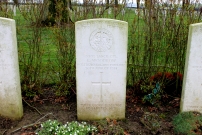| First Name: | Charles | Last Name: | WOODROW | |
|---|---|---|---|---|
| Date of Death: | 26/08/1914 | Lived/Born In: | Stepney | |
| Rank: | Lance Corporal | Unit: | Northumberland Fusiliers1 | |
| Memorial Site: | Stepney, St Dunstan Memorial | |||
Current Information:
Born-Stepney Le Cateau Military Cemetery, France
The Great Retreat of the BEF began after the opening Battle of Mons on 23rd August, 1914 and by the evening of the 25th August II Corps of the BEF, commanded by General Smith-Dorrien, had reached Le Cateau, in France. They had been retreating, but still fighting rearguard actions for two long days and they were done in. The Commander-in-Chief, Sir John French ordered the retreat to continue the next day but Smith-Dorrien chose instead to stand and fight. He reasoned that with the Germans on their heels a retreat would be disastrous without first halting the German advance. So, on the next day II Corps turned and faced the enemy. A fierce battle ensued when the Germans began an artillery bombardment at dawn. German infantry followed up in the wake of this barrage and became the targets of both the British artillery and infantry. The Germans were held at bay until the afternoon but by then they were threatening the flanks of II Corps. The BEF withdrew, whilst the Germans reorganised. British casualties for the day, killed, wounded or taken prisoner, were nearly 8,000. Le Cateau 26th August 1914 By the evening of the 25th August II Corps of the BEF, commanded by General Smith-Dorrien, had reached Le Cateau, in France. They had been retreating, but still fighting rearguard actions for two long days and they were done in. The Commander-in-Chief, Sir John French ordered the retreat to continue the next day but Smith-Dorrien chose instead to stand and fight. He reasoned that with the Germans on their heels a retreat would be disastrous without first halting the German advance. So, on the next day II Corps turned and faced the enemy. A fierce battle ensued when the Germans began an artillery bombardment at dawn. German infantry followed up in the wake of this barrage and became the targets of both the British artillery and infantry. The Germans were held at bay until the afternoon but by then they were threatening the flanks of II Corps. The British withdrew, whilst the Germans reorganised. British casualties for the day, killed, wounded or taken prisoner, were nearly 8,000. At 6am on 26 August German artillery opened fire. This was followed at 6.30am by infantry attacks which penetrated the outskirts of Le Cateau. The two flanks of II Corps immediately came under severe pressure but 3rd Division in the centre, where 9 Brigade held the line west from Troisvilles to Audencourt, were initially spared the ferocity of this attack. Later in the morning heavy German artillery fire hit Troisvilles and the right company of the 1st Northumberland Fusiliers battalion were forced back by this. At 3.30pm, 9 Brigade were ordered to withdraw and 1st Northumberland Fusiliers withdrew with little loss. They retired to the ridge between Bertry and Montigny to cover the retreat of the rest of 3rd Division. Although not as badly hit as other battalions, 1st Northumberland Fusiliers did suffer some casualties during the day’s fighting, one of whom was Charles Woodrow. |
||||
| « Back to Search Results | ||||
| If you think any of the information shown here is incorrect, Click Here to submit your amends and comments | ||||




